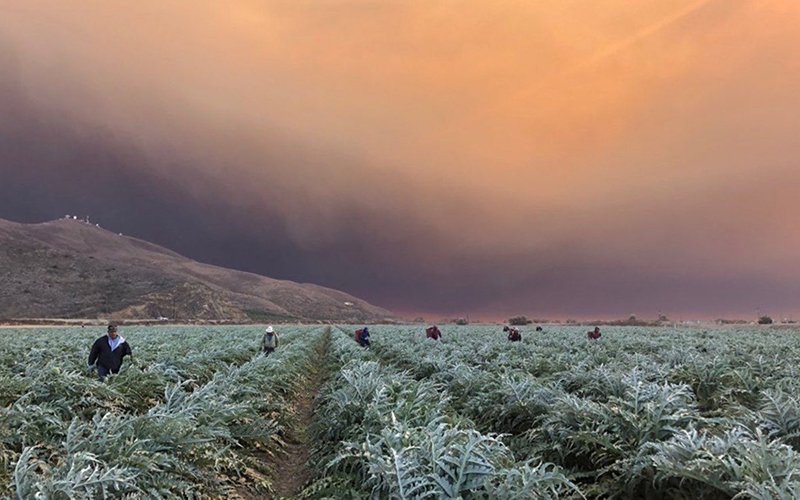A ‘tainted’ wine is one in which an outside impurity makes its way into your glass.
When wildfires strike, the residue of the smoke can settle on grape vines, leaving a film of volatile phenolic compounds. They infiltrate the grape skin, forming bonds with the sugars just inside the skins. These compounds are called glycosides.
These glycosides aren’t the problem. They’re bonded and stable. If you popped a grape in your mouth, you wouldn’t notice. The problem is that the acidity produced and released during the crushing, soaking, and fermenting of the must breaks down the glycosides making them unstable.

Now that we know that the compounds formed when smoke settles on grapes is inside the grape skin, it clears up the first question: Can’t they just rinse it off? Clearly not.
Winemakers and wine scientists noted that primary determinants for whether smoke-exposed grapes develop smoke taint are:
- The stage of grapevine growth (Are there grapes? Where are they in development?)
- The grape variety (white grapes do not transmit as much taint as red, thick skinned grapes)
- Smoke composition
- Length of smoke exposure
The smoke, once it arrives, is a fact of life. Some growers leave the fruit on the vine, never to make it into the bottle. Other growers will sell off to the bulk market. It’s a matter of economics for the agricultural side of the wine industry: can you take the hit, is your crop insured, or do you need to make a living?
Grapes themselves can be treated with ozone to eliminate the precursor glycoside compounds. The innovative technology shows promise but seems to also eradicate the unique flavors which define certain wine styles in regions. Where a slightly smoky Cabernet Sauvignon may have been interesting, the treated grapes produced an utterly tasteless glass. Some winemakers will employ techniques like carbon filters or highly specialized yeasts to minimize the smoke taint.
Was there smoke taint in the California 2017 vintage?
For the 2017 harvest and Northern California’s wildfires, the prognosis is for minimal smoke taint. Most of the fruit had been harvested before the fires broke out.
But what of the wines in tank in those smoked out wineries and cellars? Good news there, the fermentation process produces quite a bit of carbon dioxide. This carbon dioxide provides something of a protective blanket from smoke. The glycosides formed just inside of the grape skins when smoke settles on grapes in the vineyard don’t form in must, so there’s no stable compound to destabilize.

Is there smoke taint in the California 2020 vintage?

A major difference in this year’s fires compared to the 2017 disaster is that they arrived earlier in the growing season, meaning more grapes were still unharvested on the vine, increasing concerns over smoke taint. For vineyards that produce their own wine, worries about smoke taint can lead to the daunting choice of whether to use fruit or not. But the issue becomes even more complicated for growers that sell their grapes to outside winemakers if those producers attempt to reject potentially tainted fruit.
Complicating the issue is that this year’s fires were so large and so many grapes were potentially affected that the laboratories that test for smoke taint are facing massive backlogs. Berry testing backlogs are as much as 1-2 months from submission. Growers and winemakers don’t always have the luxury of time to wait around for results.
Numerous growers have reported that wineries will not schedule delivery of grapes under contract until laboratory test results are available to indicate the grapes are unaffected by smoke compounds. In other instances, wineries have delayed harvest and grape deliveries pending the completion of small-batch or micro-fermentations of grapes and resulting analyses. These delays mean many growers face the prospect of significant crop losses.
Unless specified in a contract, no buyer should believe they are entitled to reject a grower’s grapes based on concerns over smoke damage without corroborating evidence that the grapes have, in fact, been damaged. The presence of smoke in a vineyard does not mean the grapes from that vineyard will be smoke damaged.
In areas where the taint is low, some producers may opt to use mildly tainted wine for second or bulk labels. Where there’s a high likelihood of smoke taint, grapes are being rejected.

What is a consumer to do?

Your best bet? Transparency. Look for wine producers and labels that you know, opt for makers who have a reputation to protect.
If you buy a bottle from a smoky vintage and you get an unlikely mouthful of ash, cork the bottle and let the winery or wine shop know. While pushing through, year in and year out, the industry understands that quality matters.
There’s no 100% guarantee for the elimination of smoke taint. Your best bet to protect yourself is to drink what you enjoy from makers you trust. Most brands aren’t actively working to let you down.

